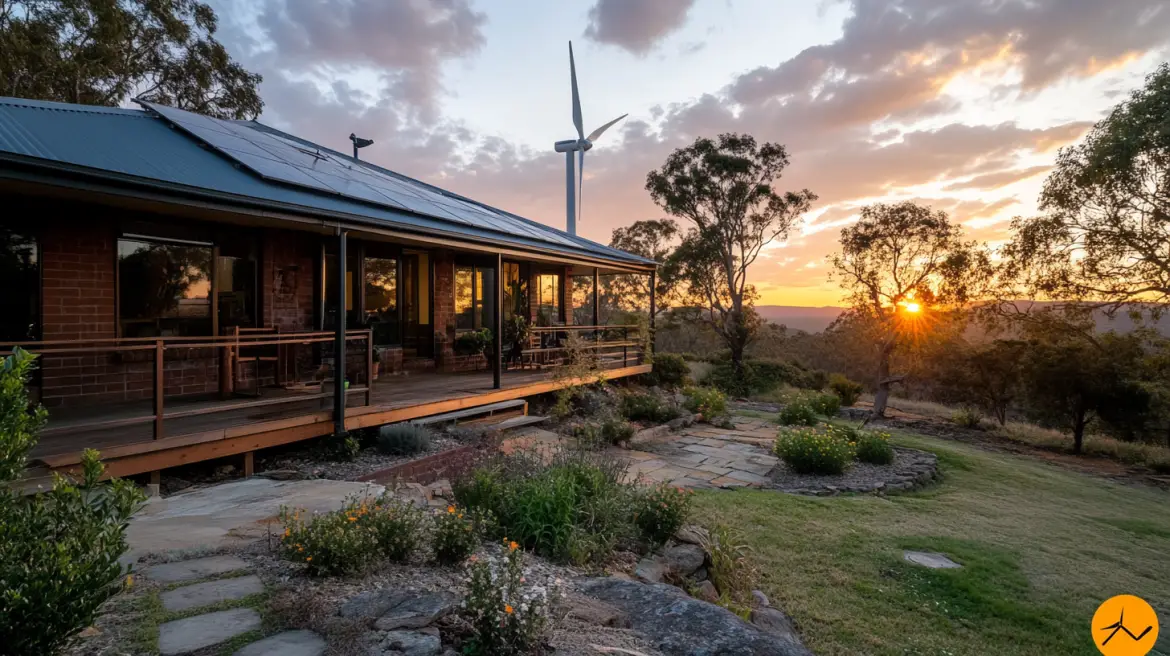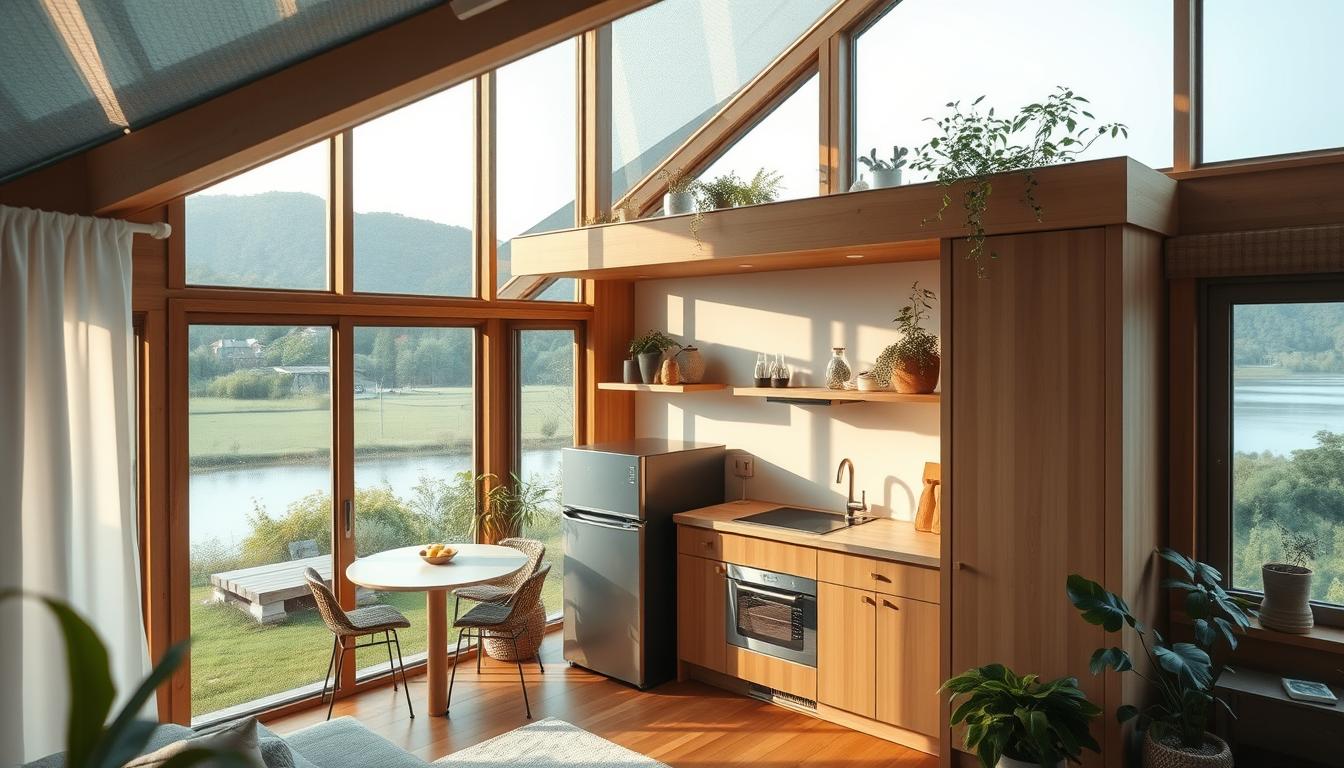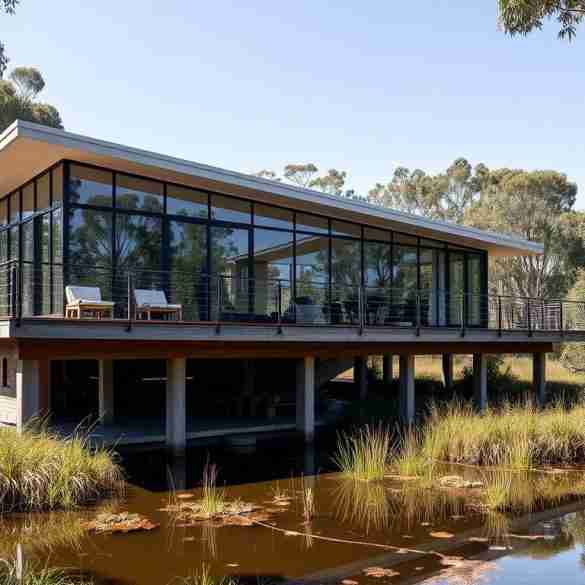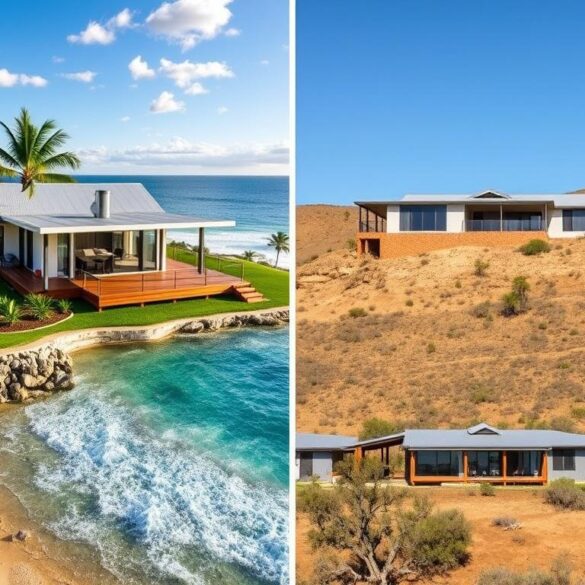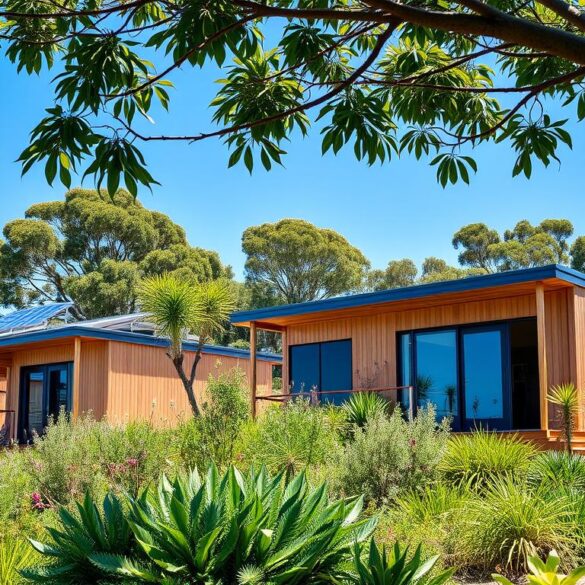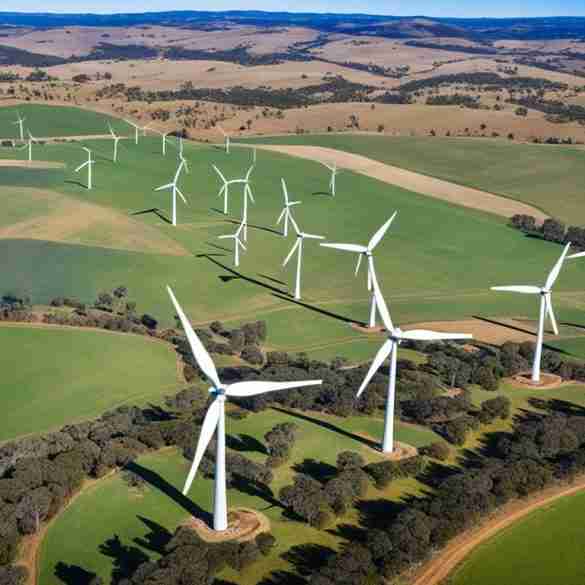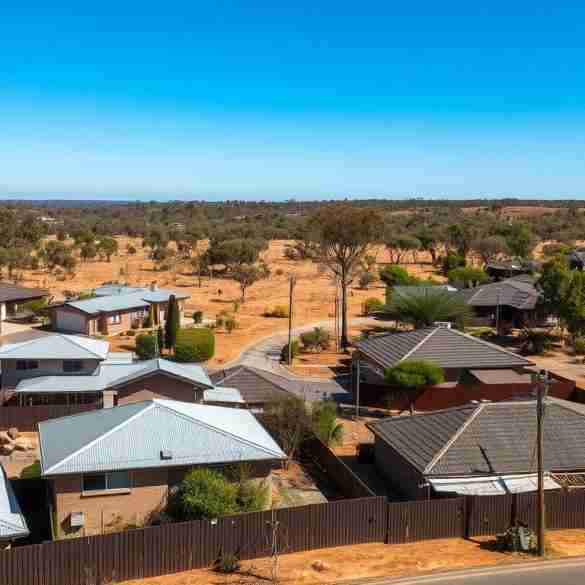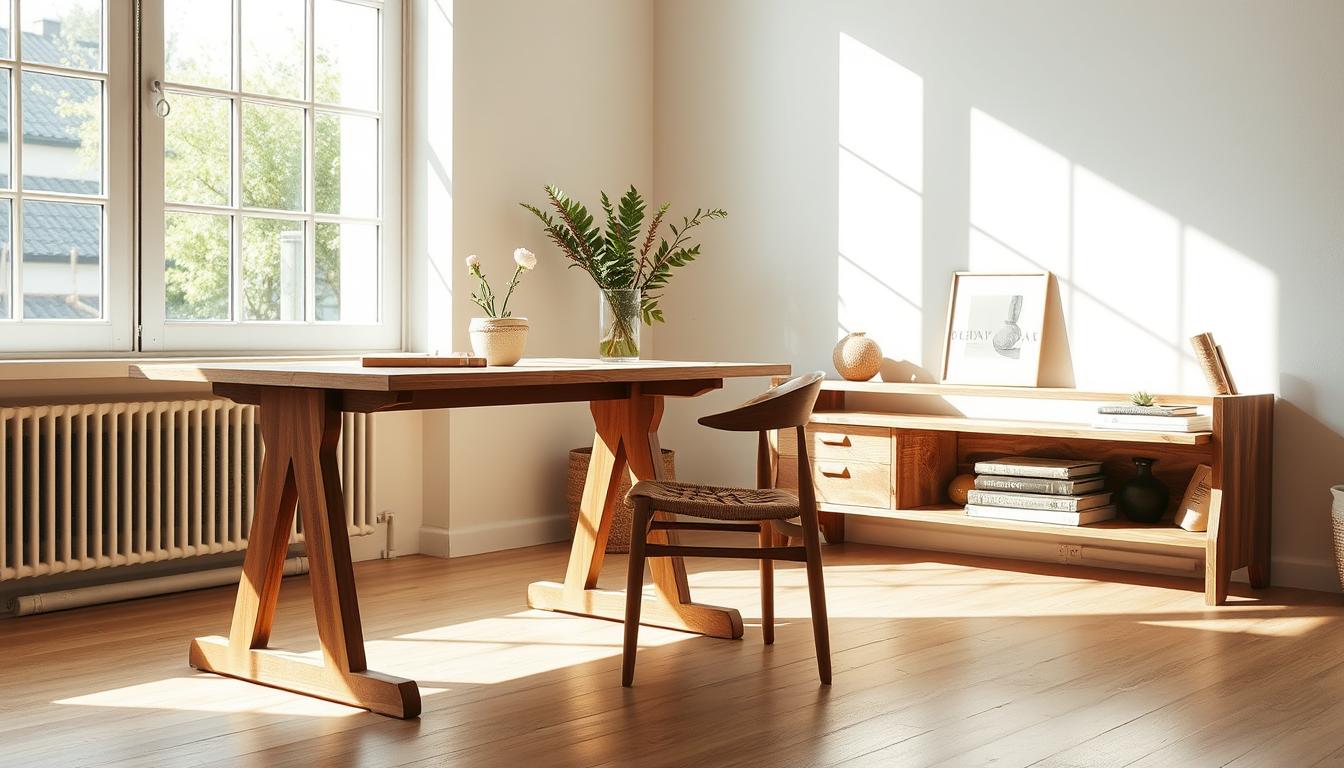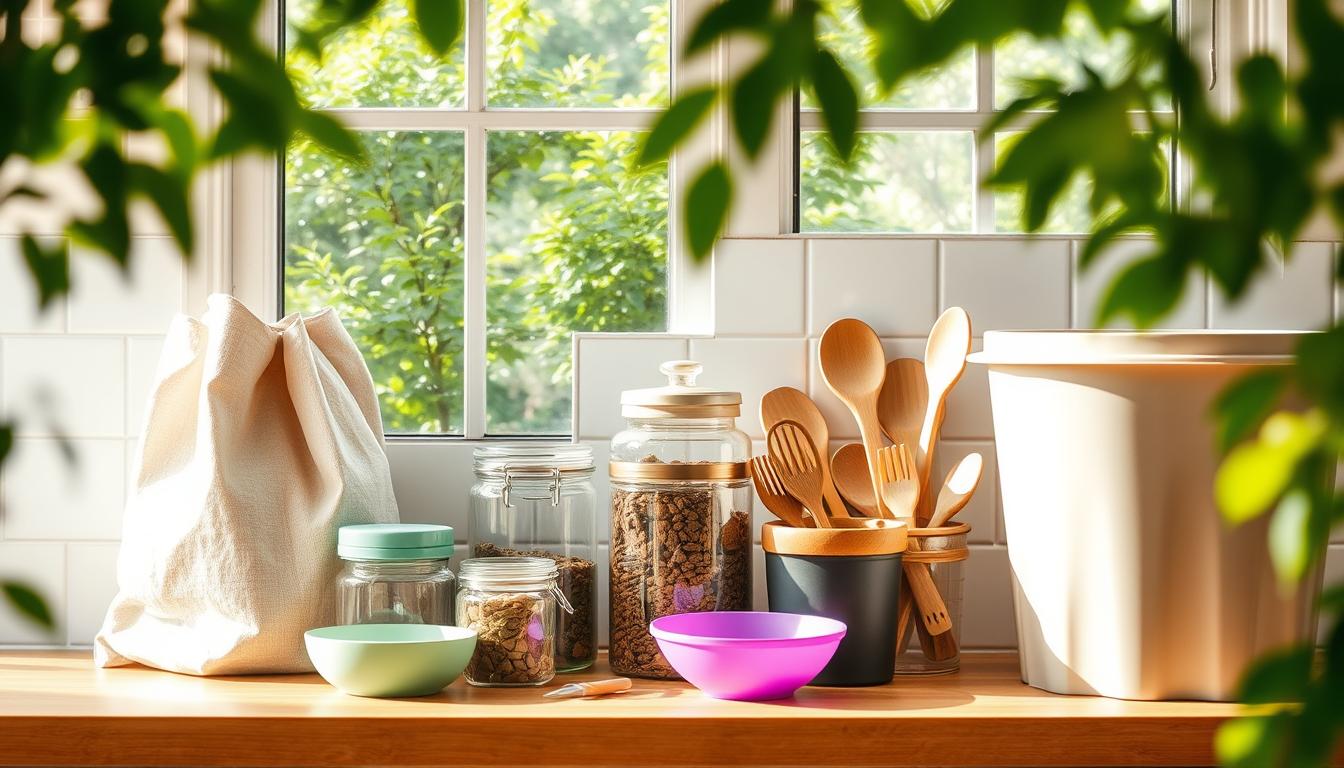Australia is moving towards renewable energy. Homeowners are now using residential wind turbines to make electricity. These turbines are a green and cost-saving way to power homes.
There are many types of wind turbines for homes in Australia. They range from small ones for rooftops to big ones for cities. You can use them with the grid or off-grid, making your power.
Today’s wind turbines are better than before. They’re quieter, more efficient, and easy to set up. This makes them a great choice for anyone wanting to save on bills or help the planet.
We’ll examine why wind turbines are good for homes, the types you can get, and how to know if one is right for you. If you want to cut your energy costs or live greener, a wind turbine might be the answer.
Table of Contents
Key Takeaways
- Residential wind turbines are becoming more popular in Australia for making home electricity.
- They can work with the grid or off-grid, giving you steady home power.
- There are many sizes and types, like rooftop and city wind turbines.
- Getting a wind turbine can lessen your reliance on the grid, cut carbon emissions, and save on bills.
- To see if a wind turbine fits your home, check your wind conditions and consider where to place it.
Podcast about the info in the article if you prefer to listen to the main points.
The Rise of Residential Wind Turbines in Australia
Australians are now choosing renewable energy like wind power to reduce carbon emissions. The cost of residential wind turbines in Australia is coming down. More people are thinking about putting up backyard wind turbines.
Wind energy in Australia made 31.8 thousand gigawatt hours of electricity by 2023. This is about 8% of the country’s electricity. Australia wants 50% of its electricity from wind by 2030. This goal is making a big investment in wind energy, worth $22.7 billion by 2024.
Victoria and South Australia are leading in using wind energy. They make about 11.8 thousand and 6.3 thousand gigawatt hours of electricity from wind, respectively. These states see wind power for homes as a key renewable energy option.
Wind power isn’t just for land. Offshore wind could make up to 5,000 gigawatts of electricity. Over ten projects are waiting to be approved. Victoria’s Star of the South project could give up to 20% of the state’s electricity.
More Australians are choosing wind power for their homes. By using backyard wind turbines, homeowners can use less fossil fuel. They also help the country move to renewable energy sources.
Benefits of Installing a Home Wind Turbine
Putting in a home wind turbine has many perks for Aussie homeowners who want to live sustainably. It lets you use wind power to cut down on traditional energy use. This means you get clean energy right at your home.
Reduced Electricity Bills
Installing a home wind turbine can save you a lot on your electricity bills. Small systems can cut your energy costs by 50% to 90%. This depends on where you live and how much wind you get. Making your energy means you use less from the grid and save money over time.

Lower Carbon Footprint
If you care about the planet, you’ll want to lower your carbon footprint. Using Australian renewable energy like wind turbines helps a lot. Wind energy doesn’t pollute and fights climate change. It makes the future greener for all of us.
Energy Independence
Having your energy source is a big plus when using wind turbines. You don’t need the traditional power grid as much. This is great for homes in far-off places where getting to the grid is hard or expensive. With wind turbines, you can have steady, reliable power even in the most remote spots.
| Benefit | Description |
|---|---|
| Lower Electricity Bills | Small wind electric systems can reduce energy costs by 50% to 90% |
| Reduced Carbon Footprint | Wind energy is clean and emission-free, promoting environmental sustainability |
| Energy Independence | Generating your own electricity reduces reliance on the grid, ideal for remote areas |
Choosing domestic wind energy is a big step towards a sustainable life. It brings many benefits to your home and helps make Australia greener. When you look into residential wind turbines, think about how they help your family and the planet.
Types of Residential Wind Turbines in Australia
Looking into wind power for your home in Australia? It’s key to know the different wind turbines out there. There are two main kinds: horizontal-axis and vertical-axis turbines. Each has its benefits and features.
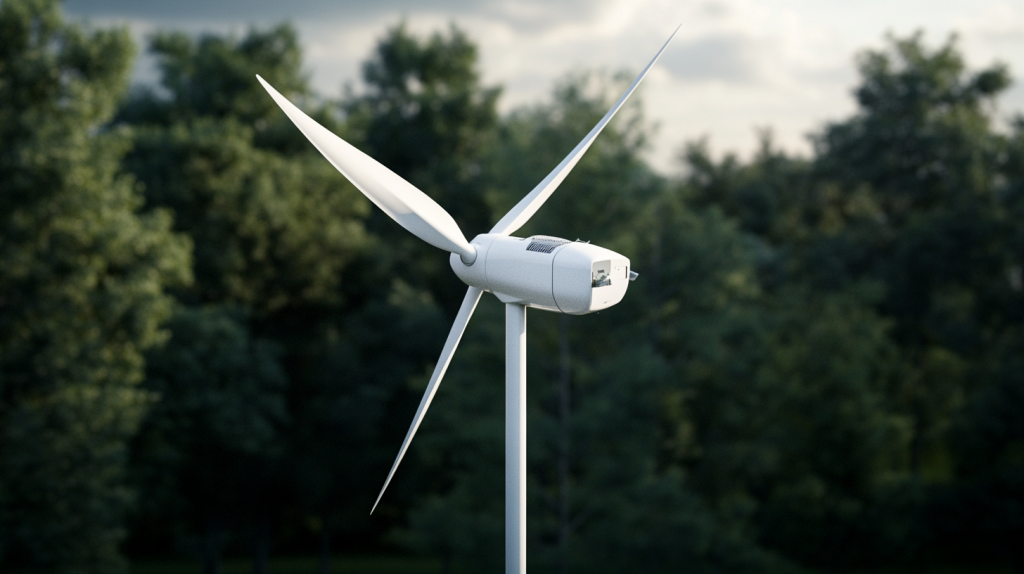
Horizontal-Axis Wind Turbines
Horizontal-axis wind turbines (HAWTs) are the top choice for homes. They have a motor shaft that runs horizontally and sit high on a tower. These turbines work better with the wind and can reach higher speeds. They’re perfect for off-grid living or adding to your home’s power in windy areas.
Here are some pluses of horizontal-axis wind turbines:
- They turn wind into electricity more efficiently
- Can reach stronger winds at higher heights
- Great for open spaces with little wind blockage
- Well-studied and widely used technology
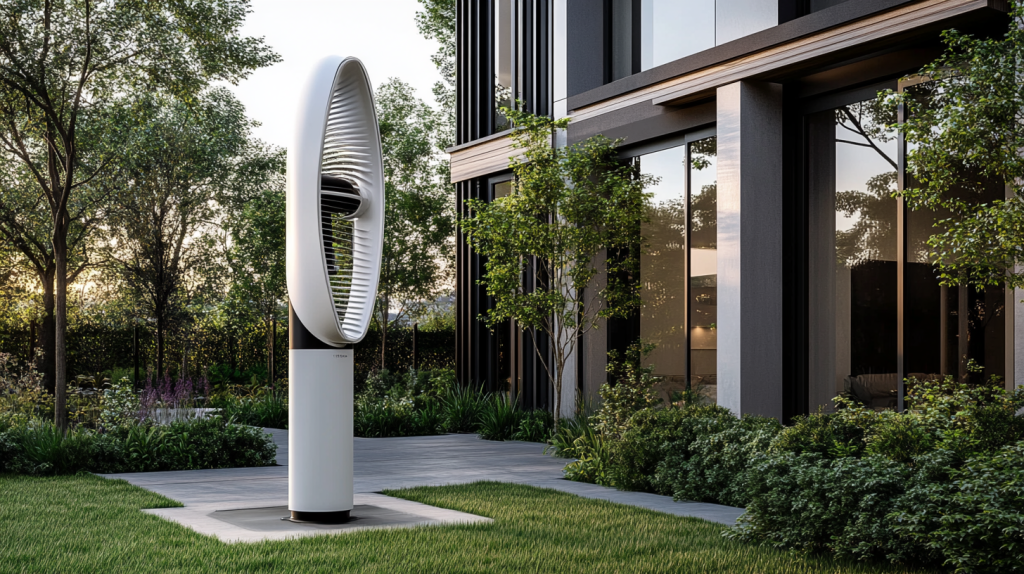
Vertical-Axis Wind Turbines
Vertical-axis wind turbines (VAWTs) offer a different take on wind power. Their blades spin around a vertical shaft, with the gear and generator at the bottom. These turbines catch wind from all sides, no need to turn them to face the wind.
VAWTs have some cool features:
- Can use wind from any direction
- Don’t need to be as tall to work well
- Less stress on the base due to the vertical setup
- They’re quieter than horizontal turbines
When picking a wind turbine for your Australian home, think about your space, wind, rules, and looks. Both horizontal and vertical turbines can cut down on your electricity bills and carbon emissions.
Determining the Feasibility of a Wind Turbine for Your Home
Before getting a wind turbine installation in Australia, check if your property is right for wind power. You need to look at your wind resource and site details. This will help decide if a small wind generator works for your home.

Assessing Your Wind Resource
Checking the wind at your place is key to seeing if a wind turbine is a good idea. Experts use wind speed data, maps, and site visits to figure out wind conditions. If wind speeds are under 5m/s, a turbine might not be worth it.
The power curve shows how much power a turbine makes at different wind speeds. Using anemometers can help measure wind at possible turbine sites. But, predicting wind in cities is hard because of obstacles.
Site Selection and Considerations of Residential Wind Turbines in Australia
Choose a spot for your wind turbine that’s high and open, away from trees and buildings. Think about these things:
- How close it is to neighbors and noise issues
- Local rules about building and zoning
- Getting to the site for setup and upkeep
- How far the turbine is from your electrical setup
Wind turbines might be cheaper upfront than solar panels in windy areas. But, installing and connecting them costs about $10,000 in Australia.
“Field trialling is suggested to assess local urban wind regimes, technical performance of turbines, noise output, planning issues, grid connection negotiations, and community acceptance of domestic wind turbines.” – Sustainable Home Magazine
There aren’t many wind turbines in Australia, mostly horizontal ones. If you’re looking at an off-grid wind power solution, remember they don’t always work well. They can take a long time to pay back.
Residential Wind Turbines in Australia
Australia is perfect for using wind energy for homes because of its strong winds. Wind turbines are becoming popular among homeowners. They help cut down electricity bills and reduce carbon emissions. Companies like TESUP offer turbines that can make up to 10 KW of power, starting with low wind speeds. They are trusted by customers in over 50 countries, including Australia.
Customers in Victoria, New South Wales, and South Australia love TESUP wind turbines. The V7 model is great for catching wind from any direction. When used with solar energy, like the H7 turbine and FLEX solar panel, homeowners save a lot on bills. Some even have to pay no electricity bills.
To see if a wind turbine works for you, check your local Australian wind resources. Wind speeds change with the seasons, with stronger winds in winter. Coastal areas get sea breezes in summer. Finding out your area’s wind speed can be hard, but government programs are helping with tools.
| System Type | Minimum Average Annual Wind Speed |
|---|---|
| Off-grid small wind systems | 4-5 m/s |
| Grid-connected systems | Greater than 6 m/s |
The height of the wind turbine tower is key to its performance. Wind speeds get faster with height, letting turbines on tall towers make more power. The turbine rotor should be at least 10m above the tallest thing nearby for best results. In open areas, towers of 24m or more are best, and keep them 300m away from steep slopes.
“The H7 wind turbine and the FLEX solar panel have been incredible for our home in Australia. They efficiently generate power even in varying weather conditions, and we’ve seen a significant reduction in our electricity bills.” – Satisfied TESUP customer
When picking a wind turbine, think about the ‘cut-in’ wind speed, especially in places with light winds. Also, know that wind can get turbulent near obstacles, affecting up to two times the obstacle’s height and 20 times its distance downwind.
As small wind standards and certifications improve in Australia, homeowners will have better and more reliable wind turbine options. By checking their wind resources and choosing the right turbine and tower, Australians can make the most of wind energy. This will help make our future more sustainable.
Connecting Your Wind Turbine to the Grid
When thinking about adding a wind turbine to your Australian home, you need to know how to connect it to the grid. You can choose from grid-connected, off-grid, or hybrid solar and wind systems. Each option depends on your needs and where you live.
Grid-Connected Systems of Residential Wind Turbines in Australia
Grid-connected wind turbines are the most common for homes. They let you send extra electricity back to the grid and get credits on your bill. When your turbine doesn’t make enough power, you can use electricity from the grid.
This setup gives you reliable power and cuts down on fossil fuel use.
Off-Grid Systems of Residential Wind Turbines in Australia
Off-grid turbines are best for homes far from the grid or those wanting total energy freedom. They store your turbine’s electricity in batteries for later. Adding solar panels makes a hybrid system for a steady power supply.
Off-grid systems give you more control but need careful planning to meet your energy needs.
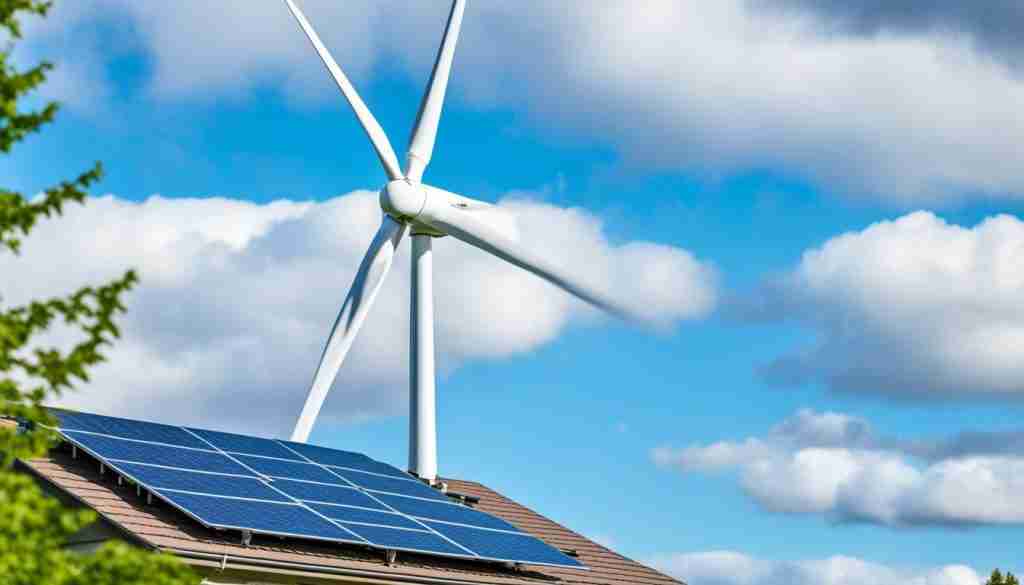
Hybrid Solar and Residential Wind Turbines in Australia
Hybrid systems use both wind and solar power for a steady and efficient energy supply. In Australia, wind is strong in the evenings and mornings, and solar in the day. This mix helps you use energy all day.
Hybrid systems can be connected to the grid or off-grid, based on what you prefer and where you live.
Choosing a hybrid system means checking if your wind turbine works with your solar inverter. Some inverters won’t work with wind turbines, so you might need a special hybrid inverter. Thinking about costs can help decide if adding wind power to your solar setup is worth it.
Australia leads in renewable energy, with projects like Snowtown 2 Wind Farm and Gullen Solar Farm showing how wind and solar work well together.
More Australians are looking into small wind turbines and hybrid systems to lower their carbon footprint and be more energy-independent. By looking at your energy needs, wind resources, and site, you can pick the best way to connect your turbine to the grid. This way, you can enjoy clean, renewable power.
Choosing the Right Wind Turbine and Tower Height
Choosing the right wind turbine and tower height is key for your backyard wind energy system. It’s important for the best performance and fitting into your green home. Wind speed and turbulence change with height. So, putting your wind generator on the tallest tower you can afford is best.
In Australia, wind turbines can be 40m to 90m long, with towers up to 150m tall. But, residential wind turbines are much smaller. Offshore turbines in Europe are huge, like General Electric’s 12-megawatt Haliade-X with 107m blades and a 260m height.
For home wind power, the best wind speed is 18 km/h or more. You need at least 0.5 acres of open land and a tower over 12.8 meters tall if allowed by local laws.
To avoid wind turbulence, put your generator at least 6 meters above nearby obstacles within 76 meters. Taller towers catch better wind and produce more power but cost more. Here are tower options for your home wind generator:
- Guyed towers: Less expensive but need a lot of space for the guy wires.
- Monopole towers: More costly but easy to maintain and can be lowered in bad weather.
When picking a tower height for your backyard wind energy, think about these things:
| Factor | Description |
|---|---|
| Surrounding Obstacles | Towers should be at least 24m high in flat areas with no obstacles within 150m and 300m. Avoid steep bluffs or sharp elevation changes. |
| Ground Clutter | If your site has clutter, make sure the tower is tall enough. The turbine rotor’s bottom should be at least 10m above the tallest nearby tree or obstruction within 150m. |
| Energy Output vs. Cost | Think about how much energy you want versus the cost of the tower and generator. |
Don’t put small wind generators on rooftops because they can cause vibrations. For best wind power, aim for clear access to the wind, like over water or smooth ground.
Always get permission from your local council and tell your neighbors about your plans. This helps keep the environment safe and relationships good.
By picking the right wind turbine and tower height, you can make your backyard wind energy system work better. This helps make a greener future.
Installation and Maintenance of Residential Wind Turbines
Using wind energy in Australia needs the right setup and upkeep of your wind turbine. These systems can be from 300 watts to 5kW, with most around 1kW. Working with experts and following a maintenance plan is key for good performance and long life.
Professional Installation of Residential Wind Turbines in Australia
Choosing a certified installer from the Clean Energy Council is vital for your wind turbine’s success. They know how to pick the best turbine size and tower height for your place. They consider wind speed, obstacles, and how close it is to the battery bank for the best results.
For homes, wind turbines sit on towers 10-20m tall. The right tower design lets you get to it for upkeep and has special features like tilting towers. Installers also add safety features like brakes to stop damage in strong winds.
Regular Maintenance and Inspections of Residential Wind Turbines in Australia
Keeping your wind turbine running well means regular checks and upkeep. Makers suggest how often to do this, which might include:
- Checking for loose bolts and connections
- Inspecting blades for damage or wear
- Lubricating moving parts as needed
- Monitoring the performance of the wind turbine and its components
- Testing and maintaining the electrical system, including batteries and inverters
After big storms or if you hear strange noises, check your turbine and tower. Fixing problems fast helps avoid bigger issues and keeps your turbine working well.
| Wind Turbine Size | Daily AC Load at 3m/s Wind Speed | Daily AC Load at 10m/s Wind Speed |
|---|---|---|
| 300W | 207 Wh | 3,741 Wh |
| 1kW | 690 Wh | 12,470 Wh |
| 5kW | 3,450 Wh | 62,350 Wh |
With a professional setup and regular care, your wind turbine will keep making clean energy for a long time. This helps make Australia more sustainable.
Case Studies: Residential Wind Turbines in Australia
More Australian homes are now using wind energy. Thanks to new wind turbines, it’s easier for homes to make their own electricity. These turbines are made for homes and work well in many places.
Jamie from Victoria got a V7 wind turbine for his house. This turbine takes the wind from any direction for steady power all year. Jamie saves a lot on his bills and helps the planet too.
“Installing the V7 wind turbine was a game-changer for my home. Not only am I saving money on energy costs, but I’m also doing my part to reduce my carbon footprint. It’s a win-win situation.” – Jamie, Victoria
Kim W. in New South Wales chose the Tesup V7B turbine. It’s small but powerful, making a lot of electricity even in low-wind areas. With solar panels and wind energy, Kim uses less grid power.
| Wind Turbine Model | Location | Annual Energy Generation | CO2 Emissions Reduction |
|---|---|---|---|
| V7 | Victoria | 8,500 kWh | 7.1 tons |
| Tesup V7B | New South Wales | 6,800 kWh | 5.7 tons |
These stories show how wind power can help Australian homes. By using new wind turbines, families can save money and fight climate change. They make a big difference with every gust of wind.
Final Thoughts for Residential Wind Turbines in Australia
Australians are looking for ways to live more sustainably. Residential wind turbines are becoming a popular choice for renewable energy. They help homeowners cut down on electricity bills and reduce carbon emissions.
Choosing the right spot and the right turbine is key. Working with experts ensures a smooth setup and good performance. Keeping your turbine in good shape is also important for its long life and efficiency.
As technology gets better, more Australians are turning to wind power. By using Residential Wind Turbines in Australia, you can help fight climate change. Join others in making a change for a better future. Visit Sustainable Home Magazine at https://sustainablehomemag.com to learn more about living sustainably and renewable energy.

